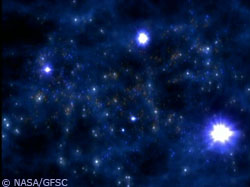Evolution of primordial stars
 (G. Meynet & S. Ekström)
(G. Meynet & S. Ekström)
Constraints on the first stellar generations can come from various types of observations: first, the study of extremely metal-poor stars from the halo give important insights on the composition of the ejecta of the first stellar generations. Second, some very indirect constraints on the nature of these first stars can be obtained from the UV outputs necessary to reionize the Universe at high redshift. Third, in the future, the possibility to observe high redshift galaxies, whose populations are dominated by these first stellar generations will probably bring new clues on these stellar populations. At the present time, the study of the chemical abundances of extremely metal-poor stars appears as the most promiseful way of constraining the first stellar generations.
The effects of rotation are numerous and at low metallicity may lead to a drastic revision of the classical picture. For instance, we have shown that the first massive star generations probably contained a high proportion of fast rotators. This seems to be required for explaining the high N/O ratio observed at the surface of very metal-poor stars (see Chiappini & al. 2006). Such fast rotation may lead for the most massive stars to strong mass loss through the effect of reaching the break-up limit and through surface enrichment by rotational mixing in CNO elements. This last feature might increase the opacity at the surface and trigger strong mass loss through radiation driven stellar winds. The mass lost is enriched in newly synthesized elements, in particular in helium and CNO elements. Thus such stars enrich their surrounding in a very peculiar manner. This is particularly true if the stellar remnant is completely swallowed by the black hole. In that case, the winds would be the sole contribution of these stars to the chemical enrichments. Interestingly, the composition of the wind ejecta present many similarities with the abundance pattern observed at the surface of extremely metal-poor C-rich stars, supporting the view that at least part of them could be formed from such ejecta.
A grid of metal-free stellar models is being computed by Sylvia Ekström, who has started her PhD in September 2004. In addition to this, further computations will be made in order to explore the following questions:
- What would be the contribution of very fast rotating Pop III massive stars to the ionizing flux ? These stars would follow an homogeneous evolution, remain in the blue side of the HR diagram, have their lifetime increased and would become WR stars. Would these effects be sufficiently strong for them to be important sources of ionizing photons ?
- What would be the ultimate fate of such fast rotating Pop III stars ? Would they give birth to collapsars, the progenitors of GRBs ?
- Why can’t we find nucleosynthetic signature of Pair Instability Supernovae in the chemical composition of extremely metal-poor stars ? Would a strong rotation-induced mass loss allows the very massive objects to skipp the Pair-instability regime ?
- Does the dynamo mechanism of Tayler-Spruit work in Pop III stars ? This mechanism needs a small pristine magnetic field which will be amplified at the expense of the differential rotational energy, but does a pristine magnetic field exists in primordial Universe ? In case the Tayler-Spruit mechanism is working, how is it affected by metallicity ?
